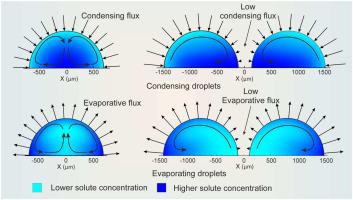当前位置:
X-MOL 学术
›
Colloids Surf. A Physicochem. Eng. Aspects
›
论文详情
Our official English website, www.x-mol.net, welcomes your
feedback! (Note: you will need to create a separate account there.)
Vapor mediated interaction of two condensing droplets
Colloids and Surfaces A: Physicochemical and Engineering Aspects ( IF 4.9 ) Pub Date : 2021-01-01 , DOI: 10.1016/j.colsurfa.2020.125555 Tapan Kumar Pradhan , Pradipta Kumar Panigrahi
Colloids and Surfaces A: Physicochemical and Engineering Aspects ( IF 4.9 ) Pub Date : 2021-01-01 , DOI: 10.1016/j.colsurfa.2020.125555 Tapan Kumar Pradhan , Pradipta Kumar Panigrahi

|
Abstract The present work investigates the internal flow structure of two condensing droplets of aqueous solution during interaction. Velocity of fluid inside the droplets was investigated by confocal micro-PIV technique. Simulation study has also been carried out to supplement the understanding of internal hydrodynamics inside droplets. Condensation on the droplets was carried out inside a closed chamber by generating a difference in vapor pressure between the droplet interface and a reservoir fluid surrounding the droplet in the room temperature without any cooling. Condensation on the droplet leads to spatial variation of solute concentration inside the droplet causing buoyancy driven Rayleigh convection. Fluid flow pattern inside a single condensing droplet is symmetric in nature whereas the fluid flow pattern for two condensing droplets is asymmetric in nature. The neighboring droplet influences the internal convection through vapor mediated interaction between the two condensing droplets. The condensing droplet senses the neighboring droplet from a distance without any physical contact. The asymmetric nature of the flow pattern is attributed to the modification in the distribution of condensation flux of the droplet in the presence of the neighboring droplet. The flow pattern observed for interacting droplets during condensation is opposite to that of evaporating droplets. The effect of the neighboring droplet on the internal convection of the condensing droplet reduces with increase in separation distance between the droplets.
中文翻译:

两个冷凝液滴的蒸汽介导相互作用
摘要 目前的工作研究了相互作用过程中两个冷凝液滴的内部流动结构。通过共聚焦微 PIV 技术研究了液滴内流体的速度。还进行了模拟研究,以补充对液滴内部流体动力学的理解。通过在没有任何冷却的情况下在室温下液滴界面和围绕液滴的储液器流体之间产生蒸汽压差,在封闭室内进行液滴上的冷凝。液滴上的冷凝导致液滴内溶质浓度的空间变化,从而导致浮力驱动的瑞利对流。单个冷凝液滴内的流体流动模式本质上是对称的,而两个冷凝液滴内的流体流动模式本质上是不对称的。相邻的液滴通过两个冷凝液滴之间的蒸汽介导相互作用影响内部对流。冷凝液滴在没有任何物理接触的情况下从远处感应相邻的液滴。流动模式的不对称性质归因于在相邻液滴存在的情况下液滴冷凝通量分布的改变。在冷凝过程中观察到的相互作用液滴的流动模式与蒸发液滴的流动模式相反。相邻液滴对冷凝液滴内部对流的影响随着液滴之间分离距离的增加而减小。相邻的液滴通过两个冷凝液滴之间的蒸汽介导相互作用影响内部对流。冷凝液滴在没有任何物理接触的情况下从远处感应相邻的液滴。流动模式的不对称性质归因于在相邻液滴存在的情况下液滴冷凝通量分布的改变。在冷凝过程中观察到的相互作用液滴的流动模式与蒸发液滴的流动模式相反。相邻液滴对冷凝液滴内部对流的影响随着液滴之间分离距离的增加而减小。相邻的液滴通过两个冷凝液滴之间的蒸汽介导相互作用影响内部对流。冷凝液滴在没有任何物理接触的情况下从远处感应相邻的液滴。流动模式的不对称性质归因于在相邻液滴存在的情况下液滴冷凝通量分布的改变。在冷凝过程中观察到的相互作用液滴的流动模式与蒸发液滴的流动模式相反。相邻液滴对冷凝液滴内部对流的影响随着液滴之间分离距离的增加而减小。冷凝液滴在没有任何物理接触的情况下从远处感应相邻的液滴。流动模式的不对称性质归因于在相邻液滴存在的情况下液滴冷凝通量分布的改变。在冷凝过程中观察到的相互作用液滴的流动模式与蒸发液滴的流动模式相反。相邻液滴对冷凝液滴内部对流的影响随着液滴之间分离距离的增加而减小。冷凝液滴在没有任何物理接触的情况下从远处感应相邻的液滴。流动模式的不对称性质归因于在相邻液滴存在的情况下液滴冷凝通量分布的改变。在冷凝过程中观察到的相互作用液滴的流动模式与蒸发液滴的流动模式相反。相邻液滴对冷凝液滴内部对流的影响随着液滴之间分离距离的增加而减小。在冷凝过程中观察到的相互作用液滴的流动模式与蒸发液滴的流动模式相反。相邻液滴对冷凝液滴内部对流的影响随着液滴之间分离距离的增加而减小。在冷凝过程中观察到的相互作用液滴的流动模式与蒸发液滴的流动模式相反。相邻液滴对冷凝液滴内部对流的影响随着液滴之间分离距离的增加而减小。
更新日期:2021-01-01
中文翻译:

两个冷凝液滴的蒸汽介导相互作用
摘要 目前的工作研究了相互作用过程中两个冷凝液滴的内部流动结构。通过共聚焦微 PIV 技术研究了液滴内流体的速度。还进行了模拟研究,以补充对液滴内部流体动力学的理解。通过在没有任何冷却的情况下在室温下液滴界面和围绕液滴的储液器流体之间产生蒸汽压差,在封闭室内进行液滴上的冷凝。液滴上的冷凝导致液滴内溶质浓度的空间变化,从而导致浮力驱动的瑞利对流。单个冷凝液滴内的流体流动模式本质上是对称的,而两个冷凝液滴内的流体流动模式本质上是不对称的。相邻的液滴通过两个冷凝液滴之间的蒸汽介导相互作用影响内部对流。冷凝液滴在没有任何物理接触的情况下从远处感应相邻的液滴。流动模式的不对称性质归因于在相邻液滴存在的情况下液滴冷凝通量分布的改变。在冷凝过程中观察到的相互作用液滴的流动模式与蒸发液滴的流动模式相反。相邻液滴对冷凝液滴内部对流的影响随着液滴之间分离距离的增加而减小。相邻的液滴通过两个冷凝液滴之间的蒸汽介导相互作用影响内部对流。冷凝液滴在没有任何物理接触的情况下从远处感应相邻的液滴。流动模式的不对称性质归因于在相邻液滴存在的情况下液滴冷凝通量分布的改变。在冷凝过程中观察到的相互作用液滴的流动模式与蒸发液滴的流动模式相反。相邻液滴对冷凝液滴内部对流的影响随着液滴之间分离距离的增加而减小。相邻的液滴通过两个冷凝液滴之间的蒸汽介导相互作用影响内部对流。冷凝液滴在没有任何物理接触的情况下从远处感应相邻的液滴。流动模式的不对称性质归因于在相邻液滴存在的情况下液滴冷凝通量分布的改变。在冷凝过程中观察到的相互作用液滴的流动模式与蒸发液滴的流动模式相反。相邻液滴对冷凝液滴内部对流的影响随着液滴之间分离距离的增加而减小。冷凝液滴在没有任何物理接触的情况下从远处感应相邻的液滴。流动模式的不对称性质归因于在相邻液滴存在的情况下液滴冷凝通量分布的改变。在冷凝过程中观察到的相互作用液滴的流动模式与蒸发液滴的流动模式相反。相邻液滴对冷凝液滴内部对流的影响随着液滴之间分离距离的增加而减小。冷凝液滴在没有任何物理接触的情况下从远处感应相邻的液滴。流动模式的不对称性质归因于在相邻液滴存在的情况下液滴冷凝通量分布的改变。在冷凝过程中观察到的相互作用液滴的流动模式与蒸发液滴的流动模式相反。相邻液滴对冷凝液滴内部对流的影响随着液滴之间分离距离的增加而减小。在冷凝过程中观察到的相互作用液滴的流动模式与蒸发液滴的流动模式相反。相邻液滴对冷凝液滴内部对流的影响随着液滴之间分离距离的增加而减小。在冷凝过程中观察到的相互作用液滴的流动模式与蒸发液滴的流动模式相反。相邻液滴对冷凝液滴内部对流的影响随着液滴之间分离距离的增加而减小。











































 京公网安备 11010802027423号
京公网安备 11010802027423号